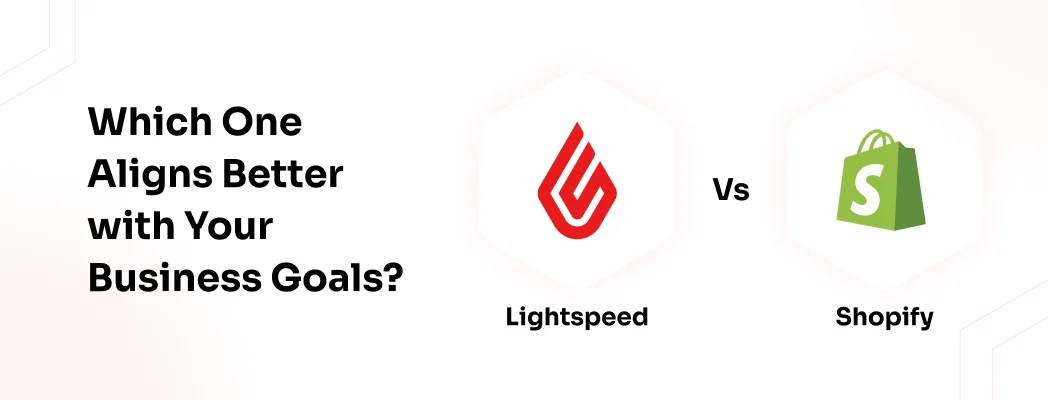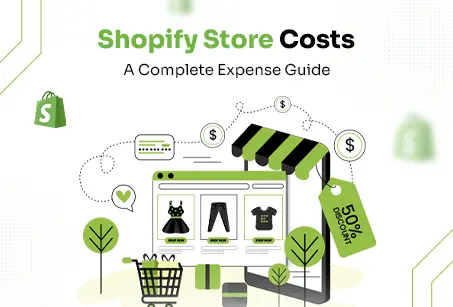
Introduction:
E-commerce is one of the fastest-growing industries these days. Over 33% of the global population shops online today. Research says e-commerce sales is growing 2X as compared to physical stores, and the numbers will continuously increase in the upcoming years. No doubt, an e-commerce store is a very powerful way to run an online business, but only if you choose the right e-commerce platform for your business. Today's market is already loaded with many great e-commerce platform options such as WooCommerce, BigCommerce, Wix, Shopify, Lightspeed, and more.
But if you ask retailers and entrepreneurs which one is best, Shopify and Lightspeed are at the top of the list. Shopify is the number 1 choice for online businesses, while Lightspeed is a favorite for retail and hospitality businesses that need strong POS and inventory tools. Comparing Lightspeed vs Shopify is an important question for business owners these days because it impacts sales, customer experience, and long-term growth.
This article will help you compare Lightspeed vs Shopify and weigh the factors to pick the right e-commerce option according to your business type and goals.
Let's have a look at the market insights before the comparison
-
Over 5 million websites are on Shopify worldwide.
-
Statista data shows Shopify controls over 10.32% of the global ecommerce platforms.
-
Lightspeed supports over 168,000 customer locations globally, especially in retail/hospitality.
-
Data shows 37% of Lightspeed stores use Facebook, 34.5% use Instagram, and 9.4% use YouTube for engagement.
-
About 66% of Shopify store owners are small business owners.
What is Lightspeed?
Lightspeed is a cloud-based e-commerce software that offers an all-in-one retail and restaurant management system. It was released in 2005 and offers POS, inventory tracking, customer management, and many great eCommerce features, so that you can handle everything from one platform.
It's most suitable for retail, hospitality, and restaurant businesses to enhance both in-store and online operations.
You must evaluate its pros and cons before choosing it for your business. Let's read the pros and cons of Lightspeed to get more clarity.
Pros of Lightspeed
-
Strong POS System: Its strong point-of-sale (POS) system helps to make in-store transactions quick and easy for retailers and restaurants.
-
Advanced Inventory Management: You can easily track stocks with Lighspeed even if you run a business from multiple locations.
-
Omnichannel Selling: You can connect your physical store and online shop, giving customers a smooth shopping experience.
-
Detailed Reporting & Analytics: It offers powerful reports to understand sales trends, best-selling products, and customer behavior.
-
Built-In CRM Tools: It has built-in CRM features which help you track customer profiles, purchase history, and loyalty programs.
Cons of Lightspeed
-
Complex for Beginners: It has a complex interface and has a lot of features, which can confuse new users.
-
Higher Pricing: It might seem costly for startups and small shops due to its software fees.
-
Limited eCommerce Features: Its specialty is strong POS, but it doesn't have enough e-commerce functionalities.
-
Extra Costs for Add-Ons: Some features require paid add-ons.
-
Dependence on Internet Connection: It’s cloud-based, hence it's compulsory to have a stable internet.
Key Features of Lightspeed:
Here are the key features of Lightspeed that make it the best option for retail and restaurant businesses.

#1. Retail POS Integration
You can easily integrate or sync your Lightspeed website with various e-commerce platforms, accounting softwares, business tools, and much more. It also supports multiple payment methods, works across locations, and syncs with inventory. If you run a restaurant, it can handle your table orders, billing, and staff management.
Overall, it makes daily operations and billing smooth.
#2. eCommerce Tools
You can connect it with in-store and online selling and set up an online store, manage products, process orders, and offer delivery or pickup options. It also supports marketing tools like discount codes and integrations with marketplaces.
#3. Inventory Management
You can easily maintain an optimal quantity of stock and prevent overstocking and running out by tracking products from the dashboard. Restaurants can check ingredients and supplies to serve customers with the required dishes on time.
#4. Customer Relationship Management (CRM)
As it has an in-built CRM tool, you can view purchase history, save contact details, and even create loyalty programs to offer a personalized experience to customers. You can use this data to send personalized offers and improve service, turning one-time buyers into repeat customers.
#5. Reporting and Analytics
You can check reports and analytics data to know top-selling items, busiest hours, and profit margins. This also helps to check the performance of sales, customers, and staff.
What is Shopify?
In simple words, Shopify is an e-commerce platform that helps people create and run online stores. It provides everything a business needs, like website design, payment processing, inventory management, and marketing tools. So even beginners with no coding knowledge can create an online store and start selling.
Pros of Shopify
-
Easy to Use: Shopify is beginner-friendly. You don’t need coding skills to set up and run your online store.
-
Lots of Themes & Customization: It has many templates and design options, so you can easily pick whatever suits for business best.
-
Powerful App Marketplace: Shopify’s app store has thousands of add-ons, hence you can easily extend features like marketing, shipping, and payments.
-
Reliable and Secure: It offers fast hosting, built-in security, and 24/7 uptime.
-
Scalable for Growth: From small shops to large brands, anyone can grow their business with Shopify.
Cons of Shopify
-
Monthly Fees Add Up: It's affordable to sell with a Shopify store, but extra apps, addons, and tools are paid there.
-
Limited Customization Without Coding: You might need to hire custom shopify development services to make a custom design and other advanced changes.
-
Transaction Fees: They charge extra transaction fees on sales if you don’t use Shopify Payments.
-
App Dependency: As most of the features are third-party in the Shopify store, your store will depend on apps and tools.
-
Basic Blogging Features: They have limited blogging tools compared to platforms like WordPress, hence you may face issues in content marketing.
Key Features of Shopify:
Let's go through the key features of Shopify to learn why millions of business runs their online business on Shopify.

#1. Store Creation and Customization
You can simply drag and drop and pick a theme relevant to your brand and modify it. Plus, if you have basic coding knowledge, you can also customize using CSS and make the store responsive according to your target audience and type of business.
#2. eCommerce Tools
Shopify has great built-in tools for managing products, processing payments, handling shipping, and tracking orders. You can run your business worldwide as it also supports multiple payment gateways and currencies. It also has features like abandoned cart recovery and discount codes.
#3. POS Features
You can also use it for your physical shops to manage sales, process payments, and sync inventory in real time. Its POS features make it easy to manage offline and online business and check everything from one dashboard.
#4. Marketing and SEO
It has various SEO-friendly features like editable meta tags to built-in email marketing, and integrations with social media platforms, and creates a strong online visibility. Moreover, you can also run promotions, create discount codes, and use analytics to see how your store is performing.
#5. App Marketplace
There are over more than 8000 apps in the Shopify app store. You can easily find the app for every feature or functionality to fulfill the growing needs of the business.
A Quick Comparison of Lightspeed vs Shopify
If you are thinking to hire any Shopify development company, or a dedicated expert, then go through the comparison table to understand the difference between Lightspeed and Shopify.
|
Features |
Light speed |
Shopify |
|
Ease of Use |
Not easy to use for beginners. |
Very beginner-friendly, simple setup with drag-and-drop tools. |
|
eCommerce Tools |
It has basic online store tools. |
It has advanced online selling tools. |
|
POS Capabilities |
Excellent POS system |
Strong POS features but mainly designed for online-first businesses. |
|
Inventory Management |
Advanced multi-location stock tracking and variation management. |
Good inventory tools, but not as detailed as Lightspeed. |
|
Marketing & SEO |
Limited marketing features, mostly depend on integrations. |
Built-in SEO, email marketing, and social media integrations. |
|
Reporting & Analytics |
Great reporting for sales, staff, and inventory insights. |
Detailed analytics, with extra insights available via apps. |
|
Integrations & Add-ons |
Fewer third-party apps, but strong built-in POS integrations. |
Huge app marketplace with thousands of extensions and plugins. |
|
Pricing |
It has free plans but can rise with adding features. It has lightspeed ecommerce, restaurant, and golf as a plan. |
It offers a 3-day free trial, then you need to choose from basic, advanced, and Shopify Plus plans. |
|
Customer support |
24/7 support through email, chat, phone support, FAQs, and more. |
24/7 support. You can contact them through email, live chat, helpdesk, knowledgebase and more. |
Lightspeed vs Shopify: A Comprehensive Analysis
Below, we will analyze both platforms in detail.

#1. Ease of Use
Shopify is easy to use due to its drag-and-drop builder and ready-made themes, add-ons, and apps; hence, anyone without a technical background can create and launch their online store.
Lightspeed is more focused on POS and retail-focused features. Using these features requires learning and knowledge of POS and the retail industry.
Final Verdict: By comparing the above things, we can see Shopify wins because of its ease of use, which helps to save a lot of time.
#2. eCommerce Features
Shopify can easily fulfill most of the e-commerce functionality due to its apps, built-in themes, marketing, SEO, and other online selling tools.
Lightspeed supports omnichannel selling. You need to perform complex retail operations to connect the offline store with the online store.
Final Verdict: Shopify performs better when it's about setting up an e-commerce store because it has many useful features like currency conversion, multiple payment gateways, multi-channel selling, and more.
#3. POS Capabilities
Lightspeed supports advanced POS systems for staff management, multi-store support, and inventory syncing. Its POS functionality is charged based on location and registers ie, usually starts from 2.6% + 10¢ per transaction.
Shopify also supports POS to customize the checkout at free cost. But its charges for POS are $5 to $89 monthly for business.
Final Verdict: So here, Lightspeed is better than Shopify because of its heavy POS capabilities and reliable transaction charges.
#4. Inventory Management
Lightspeed has the best inventory management as it has smart price assistance, wastage tracking, multi-managed inventory, tool kits, and more.
Shopify also has easy-to-use inventory tools, but for advanced features, you will need additional integrations or buy an advanced Shopify plan.
Final Verdict: Considering the above things, Lightspeed is a better option if your business is more focused on inventory management.
#5. Payment Options & Pricing
Lightspeed includes integrated payment options with some flat fees. It offers 14 14-day free retail trial. Pricing plans are grouped in categories like restaurant, retail, and golf. And further pricings are also divided into sub-categories.
Shopify offers a 3-day free trial, and you can also extend the free trial for a month by paying 1$. Shopify plans are priced at for social selling, its $5/month, for retail stores with POS, its $89/month. Online sellers can choose Basic at $25, Shopify at $65, or Advanced at $399/month. For large enterprises, Shopify Plus starts at $2300/month, with custom pricing.
Final Verdict: Shopify is more affordable due to its flexible pricing plans as compared to Lightspeed for running a big business globally.
#6. Scalability
Lightspeed scales well for businesses expanding across physical locations and stores due to its POS and inventory control.
Shopify is best for small, medium to large enterprises to scale the business digitally. You can upgrade the pricing plans according to how your business expands.
Final Verdict: Shopify is better for digital scaling, while Lightspeed is ideal for multi-store retail scaling.
#7. Customer Support & Community
You can easily contact Ligthspeed customer support through live chat, help center or call. But currently it has a small community, and customer reports that sometimes answered queries were not clear to them.
Shopify has a huge community and forums, 24/7 live chat, and call support. You can also get your query solved from the knowledge base and social media posts.
Final Verdict: Shopify is trusted by big brands and has a huge community, so it wins as customer support.
#8. Ideal For
Lightspeed is best for retailers, restaurants, and businesses needing advanced POS + inventory control.
Shopify is perfect for startups, online-first brands, and businesses that want to expand into global customers.
Final Verdict: In short, choose Lightspeed for retail-heavy needs and Shopify for online-first growth
#9. Reporting and analytics
Lightspeed supports advanced analytics and has over 40 available report templates that can be used according to store operations.
Shopify also provides detailed reports for the store's sales, category performance, and more. For advanced reports, you may need an upgraded plan.
Final Verdict: Here, it's difficult to conclude which one is better as both excel with their reporting and analytics functionalities.
#10. Integrations & Add-ons
Ligthspeed is still in growing mode and currently has over 145 apps, which can be limited for high-end business.
Shopify has already grown into the e-commerce market and has over 8000 apps for everything required to run a small to large online store.
Final Verdict: Shopify wins here as it has over more than 8000 apps, tools, and addons to complete any online store functionality.
Lightspeed vs Shopify: Which One to Choose?
Above, we have compared Lightspeed VS shopify, you might have got some idea, which ecommerce platform is best for what. Both options has its own plus and minus points, let's look a detailed breakdown below.
When to Choose Lightspeed?
-
If you run a retail store, restaurant, or multi-location business that needs strong POS and inventory management.
-
When your operations focus more on in-store sales with an option to sell online.
-
If you want detailed analytics and reporting to manage stock, staff, and customer relationships effectively.
When to Choose Shopify?
-
If your main goal is to sell online and grow your eCommerce presence.
-
If you don't have coding knowledge and want to create an online store.
-
If you want to establish your business in a huge marketplace for marketing, payments, shipping, and custom features.
-
If you are on a tight budget and want to sell online in an affordable way.
Final Thoughts on Lightspeed vs Shopify
Hope this article helped you get a clear idea about Shopify vs Lightspeed. Both platforms can create beautiful online stores; you just need to know what features and functionality align with your present and future goals. It's always a good idea to do a free trial before purchasing premium plans. Plus, always think of scalability, customer support, and flexibility because these factors will help you to fulfill growing needs.
If you are planning to launch a high-functioning Shopify store, get in touch with CommerceBizz for reliable custom Shopify development services. Whether you need to migrate your existing store to Shopify or build a new theme, we offer Shopify theme development services, Shopify migration services, and much more, along with top-notch post-launch support.
Lightspeed vs Shopify: FAQs
Q 1. How does Lightspeed Compare to Shopify? Is it the Better Option?
Ans: The Shopify platform is best for business that wants to run their store online worldwide and is constantly growing. While Lightspeed is best for brick and mortar businesses that is business with physical locations, like restaurants, groceries, banks, etc.
The better choice depends on your business type. If your business is online, then Shopify fits. Otherwise, for physical location, choose Lightspeed.
Q 2. Which Platforms and Browsers are Compatible with Lightspeed?
Ans: Lightspeed is compatible with most desktops, laptops, tablets, and even smartphones. For browsers, it supports Chrome, Firefox, Safari, and Microsoft Edge. Since it’s a cloud-based system, you just need a stable internet connection.
Q 3. Is Lightspeed a Suitable Solution for Small Businesses?
Ans: Yes, Lightspeed is a good fit for small businesses who runs retail shops, cafes, or restaurants. Its great features like inventory management, POS features, multi-location capabilities, customer tracking, and sales reporting make daily operation much easier.
Q 4. Is it Possible to Integrate Shopify with Lightspeed?
Ans: Yes, you can integrate Shopify with Lightspeed with the help of third-party solutions. By turning on automatic sync, you will be able to connect your physical store to your online store and sync inventory, sales, and customer data across both systems.




